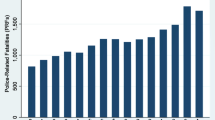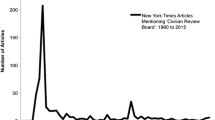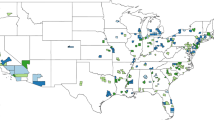Abstract
With the recent growth in scholarship in the USA regarding police killings of civilians, it is notable that the topic has gone largely unstudied in Canada even though the country faces high levels of death through legal intervention. Using data from the Canadian Broadcasting Corporation’s Deadly Force team, we conduct an event history analysis of where and when civilians in Canada are killed by law enforcement, with a particular focus on the deaths of Indigenous civilians. For both the general population and Indigenous peoples, we find that police killings of civilians are most likely in urban centres and not in Indigenous communities. Higher levels of crime severity and criminal incidents are associated with more civilian deaths, as are relatively lower incomes and housing quality. Police staffing levels are not related to deaths for either population, but killings for both populations are much less likely in areas policed by the RCMP and with higher police productivity, as proxied for by clearance rates. Higher levels of female officer employment are linked to lower civilian deaths for Indigenous peoples. These results are consistent with both racial and economic threat theories, as well as reactive hypotheses. The findings are largely consistent with the literature from the USA and suggest that previously evaluated US-based interventions, such as improving force diversity, may be able to lower deaths of Indigenous civilian deaths in Canada.









Similar content being viewed by others
Data Availability
All data used in this study are available from the corresponding author on request
Notes
We believe that this is a particularly important lens to apply, as data from the USA show that there is discriminatory use of lethal force against Indigenous peoples there as documented in Edwards et al. (2019). In the Canadian context, with a much larger Indigenous population share, there is reason to believe that these effects may be more salient, particularly if racial threat theories hold.
While we have filed PAS data for 870 communities total, there is substantial variation within these 870 communities as to the individual variables that are available. As such, when considering PAS variables, we do so in a one-by-one fashion to maintain a reasonable sample size.
This rate of growth over such a short period of time is troubling and not reflected in the USA.
From 2010 to 2014, average annual Indigenous civilian deaths numbered 3.8, but that number sharply spiked to 6.7 in 2015–2020. For the overall population, average annual law enforcement killings rose from 25.6 in 2010–2014 to 34.2 in 2015–2020.
For example, for decades, the police in Saskatoon took Indigenous civilians on “starlight tours” in which Indigenous civilians would be dropped outside of the city in the middle of the night, without clothes, in the winter months.
References
Adelman, J. 2016. Study in blue and greay: Police interventions with people with mental illness: A review of challenges and responses. Technical report, Canadian Mental Health Association BC Division.
Alpert, G.P., MacDonald J.M. Police use of force: An analysis of organizational characteristics. Justice quarterly 2001;18(2):393–409.
Ang, D. The effects of police violence on inner-city students. Quarterly Journal of Economics 2021; 136(1):115–168.
Ariel, B., Farrar W.A., Sutherland A. The effect of police body-worn cameras on use of force and citizens’ complaints against the police: A randomized controlled trial. Journal of quantitative criminology 2015;31 (3):509–535.
Blalock, H. 1967. Toward a Theory of Minority-group Relations. A Capricorn giant. Wiley.
Carmichael, J.T., Kent S.L. Structural determinants of municipal police force size in large cities across canada: Assessing the applicability of ethnic threat theories in the canadian context. International Criminal Justice Review 2015;25(3):263–280.
Clark, K., Hopkins J. 1969. A Relevant War Against Poverty: A Study of Community Action Programs and Observable Social Change. Harper Row.
Correll, J., Hudson S.M., Guillermo S., Ma D.S. The police officer’s dilemma: A decade of research on racial bias in the decision to shoot. Social and Personality Psychology Compass 2014;8(5):201–213.
Cunningham, J., Feir D., Gillezeau R. 2021. Collective bargaining rights, policing, and civilian deaths. IZA Discussion Papers 14208, Institute of Labor Economics (IZA).
Cunningham, J.P., Gillezeau R. Racial differences in police use of force: Evidence from the 1960s civil disturbances. AEA Papers and Proceedings 2018;108:217–21.
Cunningham, J.P., Gillezeau R. 2019. Don’t shoot! the impact of historical African American protest on police killings of civilians. Journal of Quantitative Criminology, pp 1–34.
Desmond, M., Papchristos A.V., Kirk D.S. Police violence and citizen crime reporting in the black community. American Sociological Review 2016;81(5):857–876.
Dharmapala, D., McAdams R.H., Rappaport J. 2019. Collective bargaining rights and police misconduct: Evidence from Florida. University of Chicago Coase-Sandor Institute for Law & Economics Research Paper (831).
Edwards, F., Lee H., Esposito M. Risk of being killed by police use of force in the United States by age, race–ethnicity, and sex. Proceedings of the National Academy of Sciences 2019;116(34):16793–16798.
Feigenberg, B., Miller C. Racial divisions and criminal justice: Evidence from southern state courts. American Economic Journal:, Economic Policy 2021;13(2):207–40.
Finch, B.K., Beck A., Burghart D.B., Johnson R., Klinger D., Thomas K. Using crowd-sourced data to explore police-related-deaths in the United States (2000–2017): The case of fatal encounters. Open health data 2019;6(1):1.
Fisk, C.L., Richardson L.S. Police unions. Geo. Wash. L. Rev. 2017;85:712.
Fryer, R.G. 2019. An empirical analysis of racial differences in police use of force. Journal of Political Economy.
Goncalves, F. 2020. Do police unions increase misconduct? Working Paper.
Hannum, N. 2003. Aboriginal deaths and inuries in custody and/or with police involvement. Technical report, Native Courtworker and Counselling Association of British Columbia.
Harvey, M. 2020. Fatal encounters between native americans and the police. Working paper, The Center for Indian Country Development.
Holz, J.E., Rivera R.G., Ba B.A. 2020. Peer effects in police use of force.
Jacobs, D., Britt D. Inequality and Police Use of Deadly Force: An Empirical Assessment of a Conflict Hypothesis*. Social Problems 1979a;26(4):403–412.
Jacobs, D., Britt D. Inequality and Police Use of Deadly Force: An Empirical Assessment of a Conflict Hypothesis*. Social Problems 1979b;26(4):403–412.
Jacobs, D., O’Brien R.M. The determinants of deadly force: A structural analysis of police violence. American journal of sociology 1998;103(4):837–862.
Kadleck, C. 2003. Police employee organizations. Policing: An International Journal of Police Strategies & Management.
Kent, S. Killings of police in u.s. cities since 1980: An examination of environmental and political explanations. Homicide Studies - HOMICIDE STUD 2010;14:3–23.
Legewie, J. Racial profiling and use of force in police stops: How local events trigger periods of increased discrimination. American Journal of Sociology 2016;122(2):379–424.
MacAlister, D., Holmes R., Association B.C.C.L. 2012. Police-involved deaths: the need for reform. Vancouver: BC Civil Liberties Association.
Marcoux, J., Nicholson K. 2021. Deadly force: Fatal encounters with police in canada: 2000-2020. CBC.
Masera, F. 2019. Police safety, killings by the police and the militarization of US law enforcement. memo. (February 27, 2019).
Morrow, W.J., Berthelot E.R., Vickovic S.G. Police use of force: an examination of the minority threat perspective. Criminal Justice Studies 2018;31(4):368–387.
Pang, M.-S., Pavlou P. A. 2016. Armed with technology: the impact on fatal shootings by the police. Fox School of Business Research Paper (16-020).
Parent, R., Verdun-Jones S. Victim-precipitated homicide: police use of deadly force in british columbia. Policing-an International Journal of Police Strategies & Management 1998;21:432–448.
Pedicelli, G. 1998. When Police Kill: Police Use of Force in Montreal and Toronto. Vehicule Press.
Rad, A.N. 2018. Police institutions and police abuse: Evidence from the US Master’s thesis, University of Oxford, Oxford.
Ross, C.T. 2015. A multi-level bayesian analysis of racial bias in police shootings at the county-level in the United States, 2011–2014, PloS one, 10(11).
Rushin, S. Police union contracts. Duke LJ 2016;66:1191.
Stelkia, K. An Exploratory Study on Police Oversight in British Columbia: The Dynamics of Accountability for Royal Canadian Mounted Police and Municipal Police. SAGE Open 2020, January;10(1):21582440198.
Swaine, J., Laughland O., Lartey J., McCarthy C. 2016. The counted: people killed by police in the US. The Guardian. https://www.theguardian.com/us-news/ng-interactive/2015/jun/01/the-counted-police-killings-us-database, Last Accessed August 8, 2020.
Wortley, S. A northern taboo: Research on race, crime, and criminal justice in canada. Canadian journal of criminology and criminal justice 1999;41(2):261.
Wortley, S., Laniyonu A., Laming E. 2020. Use of force by the toronto police service final report. Technical report, Ontario Human Rights Commission.
Wortley, S., Owusu-Bempah A. The usual suspects: Police stop and search practices in canada. Policing & Society - POLIC SOC 2011;21:395–407.
Wortley, S., Tanner J. Data, denials, and confusion: The racial profiling debate in toronto. Canadian Journal of Criminology and Criminal Justice - CAN J CRIMINOL CRIM JUSTICE 2003;45: 367–390.
Acknowledgements
We would like to thank the CBC Deadly Force team for making their data publicly available.
Funding
This research received financial support from the Social Sciences and Humanities Research Council (SSHRC).
Author information
Authors and Affiliations
Corresponding author
Ethics declarations
Conflict of Interest
The authors declare no competing interests.
Additional information
Publisher’s Note
Springer Nature remains neutral with regard to jurisdictional claims in published maps and institutional affiliations.
Appendix:
Appendix:
Total deadly force incidents by armed status. Notes: All deaths by legal intervention by armed/unarmed status from Marcoux and Nicholson (2021)
Indigenous deadly force incidents by armed status. Notes: Indigenous deaths by legal intervention by armed/unarmed status from Marcoux and Nicholson (2021)
Total deadly force incidents by police type. Notes: All deaths by legal intervention from Marcoux and Nicholson (2021) by policing jurisdiction as calculated by the authors
Indigenous deadly force incidents by police type. Notes: Indigenous deaths by legal intervention from Marcoux and Nicholson (2021) by policing jurisdiction as calculated by the authors
Total deadly force incidents by region. Notes: All deaths by legal intervention from Marcoux and Nicholson (2021) by region
Indigenous deadly force incidents by region. Notes: Indigenous deaths by legal intervention from Marcoux and Nicholson (2021) by region
Indigenous deadly force incidents by community type: Indigenous and non-Indigenous. Notes: Indigenous deaths by legal intervention from Marcoux and Nicholson (2021) by whether a community is an Indigenous community from the CWB dataset
Rights and permissions
About this article
Cite this article
Gillezeau, R., Rushford, D.T. & Weaver, D.N. Policing and Indigenous Civilian Deaths in Canada. J Econ Race Policy 5, 210–239 (2022). https://doi.org/10.1007/s41996-022-00097-6
Received:
Revised:
Accepted:
Published:
Issue Date:
DOI: https://doi.org/10.1007/s41996-022-00097-6











